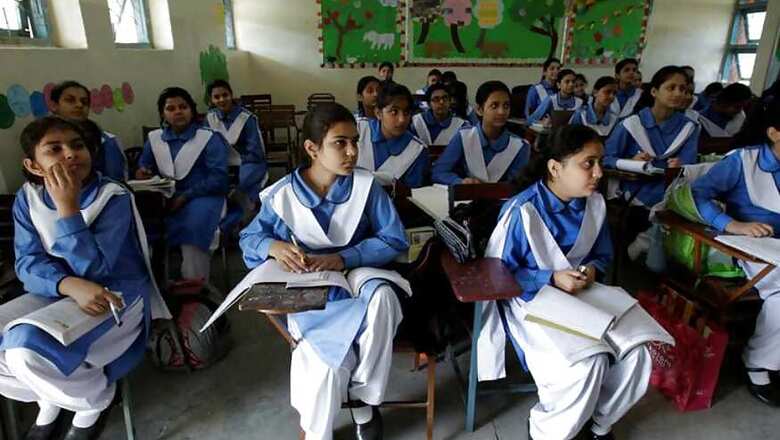
views
Dr Kasturirangan committee has apparently submitted its report on the New Education Policy. Hopefully, unlike the report submitted by TSR Subramanian Committee, this will see the light of the day in the form of policy announcement.
However, with just a few months left for the government, we cannot be sure about the possibility of implementing this policy. The other question is whether there is a need for another policy at all to address issues that beset education in the country.
There is no doubt about the fact that the school education sector is plagued by huge problems. However, perhaps the dismal performance is not on account of policy gap. This paper looks at what’s gone wrong in the school education sector and the steps that can possibly be taken to correct this.
Everyone agrees that the infrastructure (school buildings) has shown remarkable improvement during the past decade though there is still a long way to go. And, thanks to the mid-day-meal, the child has started coming to the school. However, the poor quality of education that is imparted in most of the government schools is appalling. The learning outcomes have actually come down during the past decade despite enormous amount of investment. The average pupil-teacher ratio has improved and comes close to the required levels. However, this does not solve the problem of quality.
To begin with, a large number of teachers are not qualified to teach, yet they are teaching. According to a rough estimate, out of 8 million teachers, around 1.4 million fall in this category. Politics has seeped into this cadre in the most insidious manner, resulting in skewed distribution of teachers in most of the states.
The Right to Education Act did precious little to improve the state of affairs. In fact, the legislation made the task of delivering quality education complex and difficult. The focus of the Act is primarily on ‘inputs’ (like infrastructure) rather than ‘outcomes’. It has created an adversarial role between ‘public’ and ‘private’ schools. The Act mandates under section 12(1)(c) that even private schools “shall admit in Class I, to the extent of at least twenty five percent of the strength of that class, children belonging to weaker section and disadvantaged group.”
The manner in which reimbursement is to be provided has created a number of problems.
The norms and standards prescribed in the schedule for a school are far removed from ground reality. What is perhaps desirable has been made mandatory. This has resulted in a phenomenal increase in the number of teachers. During 2015-16, there were 39,608 government schools that had less than 10 children, but each school was mandated to have minimum of two teachers. The budget private schools, most of which are doing a great job in imparting education, are under enormous pressure to meet the prescribed standards or face closure. No attempt was made while enacting this legislation to look at the ground reality.
The consequences have been disastrous. On an average, an amount of around Rs 10,000 per child gets spent in government schools. The budget schools do it for much less and impart as good, if not better, education. Unfortunately, the focus so far has primarily been on regulation (legislations are perhaps meant for that) and not on development of the private sector. Consequently, even after eight years of enactment, the country is none the better than what it was.
The RTE Act has done more damage to the delivery of education. Section 16 of the Act provides that “no child admitted in a school shall be held back in any class or expelled from school till completion of elementary education.”
The ‘expulsion’ part can be understood but not holding back a child in a class has meant that a large number of children are getting promoted without acquiring necessary attributes. The model of ‘no detention’ was apparently picked up from the West and transplanted in this country without taking into account the objective conditions obtaining here. Yet again, the consequences have been devastating as there is a huge bottleneck getting created at Class 10 where the pass percentage has plummeted. The states were not even given the freedom to take a call on the issue. The government has subsequently decided to provide an option to the states and the amendment is under consideration of Parliament.
The question now is whether a policy can correct all this. Should we be spending time in looking at a policy? Most of the action relating to education lies in the states. In any case, the country is too diverse to consider a single mandate by way of policy for the entire country. If a teacher does not go to a school in Kerala, there is a good chance that he would be “lynched”, but in some of the states of northern India, they consider it their right not to go to the school. There are instances of these regular teachers employing a “substitute” to represent them and even teach on their behalf.
What is actually required is an action plan clearly outlining what needs to be done, how it will be done, who will do it, and by when it will be done? The roles of respective entities should be clearly defined so that the performance can be assessed.
The action plan needs to focus on the teacher who plays a pivotal role in imparting education.
The entire value chain needs to be looked at, understood and interventions clearly outlined. Beginning with pre-service training, to selection process, to in-service training, to transfer and posting, to engagement of teachers in non-educational activities, to their promotional avenues and morale will need to be looked at.
Action plan for each state will have to be worked out in detail, clearly outlining the roles of the central government and the respective state government. Intervention will vary from state to state. Some initiative has already been taken in the context of preparing an action plan.
The action plan for Jammu and Kashmir has been made and put into operation. Education is being used as a tool for transformation. And it is working. The exchange of students from the Valley with those in other parts of the country has shown encouraging results. Similar plan has been worked out for Uttar Pradesh, but unfortunately it is still in cold storage. Similar plans need to be prepared in consultation with all the stakeholders and monitored closely. There will also have to be sufficient flexibility in the central schemes to accommodate the differences among states.
The whole approach has to be outcome-based rather than input-based as has been the case so far. Here, too, some initiative has already been taken through the launch of ‘Samagra Shiksha’. This needs to be carried forward in letter and spirit without indulging in a time consuming exercise of a policy.
Our country has been obsessed with the western world. We had looked at Finland, England, Scotland, Holland and all the lands of the world, but not at motherland. A lot of wonderful work is being done within the country but has so far gone unnoticed.
‘Policy’ cannot help in this regard. What needs to be done is to facilitate identification, understanding and scaling of successful practices. If these home-grown practices have succeeded in the prevalent objective conditions, the chances of their replication and scaling are pretty high as compared to an ‘imported’ idea or practice.
What is also required is to learn from states, like Rajasthan, Karnataka and Chhattisgarh that have turned it around through some remarkable state-level interventions both administrative and financial.
We have for very long kept the debate of public versus private alive. This needs course correction. There is outstanding work being done in the private domain and some of the practices in the public domain are also worthy of note. The two sides have to evolve as partners and not as adversaries. They have to learn from each other. Quality can come from the private and scale from the public. This does not require policy intervention. Some initiative has already been taken in this regard. “Shaala Sarathi” portal has been set up for this purpose. It now needs to be taken forward and scaled.
The present government can be credited with some extremely well-intentioned initiatives in the recent past. These include amendment to the RTE Act to enable unqualified teachers to graduate, doing away with the mandate of “no-detention”, a comprehensive scheme of ‘Samgra Shiksha’ treating education as a continuum, fostering public private partnership to improve outcomes, conducting arguably the largest National Achievement Survey in the world and focussing on learning outcomes. What is required is to consolidate and take these steps forward. This in itself will require stupendous effort. The intellectual debate about a policy can carry on but should not take centre stage.
(Author is former secretary of school education and literacy. Views are personal)




















Comments
0 comment